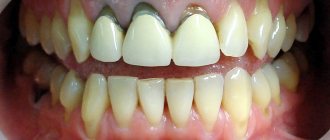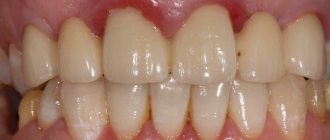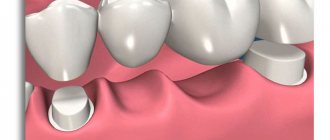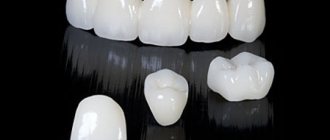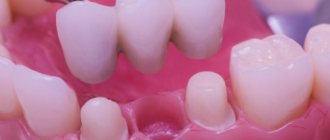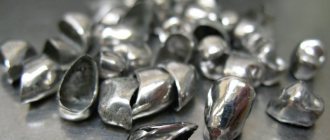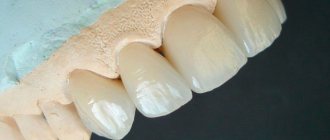- Indications
- Contraindications
- Alloys
- Kinds
- Advantages and disadvantages
- Stages of treatment
- Care
- Alternative Methods
- Advantages of the ROOTT Clinic
- Prices
- Work examples
- Doctors
- Reviews
- When to use:
any group of teeth - Material:
KHS, gold, titanium - Installation time:
7 to 14 days - Features:
high strength, durability, possibility of cladding - Service life:
up to 25 years - Type of anesthesia:
local
Cast crowns are prosthetic structures for replacing the supragingival part of a tooth, made by precision casting in a mold. They are used to compensate for single defects in the dentition, as part of bridges. Made from metal alloys, including precious ones. Thanks to the one-stage casting technique, the anatomical shape of the tooth and occlusal contacts are accurately recreated, which ensures a tight fit to the dental tissues without the formation of retention points (places where food accumulates).
Solid dental crowns are not aesthetically pleasing enough, so they are used for prosthetics of chewing teeth. During its existence, cast orthopedic systems have been regularly improved. These are strong, reliable, durable structures. A front lining made of ceramic or plastic material gives cast metal dentures a natural appearance, allowing them to be installed on the front teeth.
Contraindications
Relative
the procedure can be carried out with extreme caution
- Complex combined malocclusions;
- increased abrasion of the enamel of the antagonist tooth;
- inflammatory processes in the mouth;
- increased sensitivity of teeth;
- pregnancy;
- allergy to anesthetics;
- acute infections;
- period after radiation therapy, stroke, heart attack;
- mental disorders;
- exacerbation of a chronic disease.
Absolute
the procedure is strictly prohibited
- Teeth with living pulp in children and adolescents;
- severe periodontitis;
- oncological processes in the oral cavity;
- allergy to prosthesis material;
- decompensated diabetes mellitus.
Contraindications for metal crowns
There are a number of restrictions under which it is not recommended to place metal crowns on a patient’s teeth. Among them:
- bruxism;
- allergy to metals;
- malocclusion;
- tooth root resorption (destruction of dentin and bone tissue around the root);
- prosthetics of anterior teeth.
The last contraindication for metal crowns is included in the list of restrictions solely for reasons of aesthetics.
What metal alloys are used
The designs have several options. Cast crowns are made from metal alloys with high strength:
- Chromium-cobalt alloys (CHS)
are high-alloy steels, characterized by density, elasticity, good fluidity (in the molten state), and high resistance to oxidation and corrosion.
The mechanical viscosity of CHS is higher than that of gold alloys. A prosthesis made from casting material based on chromium with the addition of cobalt and nickel is able to withstand high mechanical loads without deformation or destruction. The service life of such structures is 12-15 years
, and the price is the most affordable. The main disadvantages are poor aesthetics and the risk of developing allergies. - Gold-based alloys
are characterized by high strength and corrosion resistance.
The high plasticity of the material allows you to create dentures that fit exactly to the dental tissues and gums. Gold solid-cast tooth crowns have properties identical to natural enamel and do not damage opposing units. They have an antibacterial effect, are biocompatible with body tissues, and do not cause allergies or rejection. To give the material sufficient strength, gold is combined with palladium, platinum, copper, and silver. Service life - 20-25 years
. Cons: poor aesthetics, high price. - Titanium alloys
– the strength of titanium prostheses is 9-10 times higher than that of structures made from other materials. Biocompatible, inert to chemical and temperature influences, the material does not have a destructive effect on antagonist teeth. Prostheses made of titanium alloys are lightweight, have precise marginal and internal fit, and are used to compensate for single defects as part of long-distance bridges. Disadvantages - titanium is difficult to process and has low adhesion to ceramics, which increases the risk of chipping the outer coating.
The crown material is selected according to the clinical picture. The doctor takes into account the specifics of the situation, offers several effective options, among which the patient chooses the optimal one in terms of price, aesthetics, and functional properties. Metal-ceramic structures are more aesthetically pleasing than all-metal or metal-plastic crowns. Plastic cladding quickly absorbs foreign odors and coloring pigments, and changes color within a few months. It is not able to withstand a full chewing load and begins to crack and chip.
Do's and Don'ts after having a crown installed
- Water is allowed to be drunk immediately, but the patient will be able to eat food no earlier than after 2 hours.
- If prosthetics was performed on a pin, the chewing pressure on the tooth must be reduced, otherwise the pin and crown may move.
- At first, it is better to limit the consumption of drinks with coloring pigments. You should also avoid foods that are too cold or hot.
- It is recommended to cut solid food into small pieces.
- It is undesirable to eat viscous and stringy food, as it can lead to a gradual deterioration in the fixation of the prosthesis and its loss.
Types of cast crowns
Cast crowns are divided into:
- all-metal
– dental caps made of shiny polished metal. They are characterized by poor aesthetics and are absolutely not similar to a natural tooth; - with sputtering
– the prosthetic structure is coated with a composition that imitates precious material (“gold-like”) using vacuum-plasma equipment. Externally, such structures look more aesthetically pleasing than all-metal ones, but the golden plating does not in any way resemble natural enamel, and moreover, it increases the risk of an allergic reaction; - with veneering
(partial, full) – partial veneering involves installing a ceramic or plastic overlay on the front part of the crown. With full cladding, the metal structure is covered with a layer of plastic or ceramic mass to give a natural look.
Orthopedic systems fully lined with ceramics cannot be called a construction made entirely of metal. These are metal-ceramic crowns with good aesthetics and high strength, which can be installed in any part of the dental arch. The negative qualities of such structures are wear, chips of the ceramic veneer, and the appearance of a dark stripe in the gingival zone (around the neck of the crown) due to oxidation of the metal frame.
Indications and contraindications
Crowns are indicated in cases where there is significant tooth damage due to carious diseases or for other reasons, if the defects cannot be eliminated with an inlay or filling. In addition, they can be used to restore the aesthetic and chewing functions of teeth. They are also indicated in cases of loss of one or more teeth.
Teeth should not be covered with these structures if there are incurable foci of chronic periodontal inflammation or teeth with pathological mobility. In addition, they are contraindicated in case of general weakening of the body after suffering serious illnesses. In more detail, the issue of the admissibility of installing solid crowns is decided individually with the dentist.
Advantages and disadvantages
Advantages
- High precision fit to dental tissues due to the correct anatomical shape;
- crown thickness is 0.3-0.5 mm, which avoids deep tooth preparation;
- durability – service life is 15-25 years;
- the possibility of spraying and cladding to improve the aesthetics of the structure;
- recreating the correct occlusion and chewing surface of the teeth;
- affordable price for manufacturing and installation.
Flaws
- Increased abrasion of the enamel of antagonist teeth;
- the need for turning;
- high thermal conductivity (due to the proximity of the pulp, discomfort and pain may occur);
- risk of allergies (except for structures made of precious metals);
- low aesthetics (excluding metal ceramics).
Gold crowns
There was a time when gold crowns were especially popular in Russia. They were one of the signs of the prosperity of the population. Currently, such prostheses are installed very rarely, although they have a number of advantages.
Gold is a precious metal and, due to its physical and chemical properties, is ideal for prosthetics. It is used for the manufacture of solid cast structures. Due to the fact that gold is a plastic material, it provides a tight fit to the tooth. Due to its strength, the gold prosthesis does not lose its shape during many years of use. This design will not break and chips will not form on it. Dentists claim that the percentage of wear of a gold product is similar to that of natural tooth enamel, which is practically not subject to much wear.
Manufacturing and installation
Dental prosthetics with cast crowns includes clinical and laboratory stages.
Clinical
- Diagnostics
– examination, making a diagnosis, drawing up a treatment plan, choosing a prosthetic system. - Preparation
- preparing the tooth for a cast crown (giving the desired shape to the stump) taking into account safety zones, taking impressions using an impression tray and plastic base masses, determining the central occlusion, fixing a provisional (temporary) crown on the stump to protect dental tissues. In case of severe destruction of the supragingival part (when only the root remains), a stump inlay is used as a platform for fixing the prosthetic structure. - Installation
– checking the quality of the finished prosthesis (fitting) in the oral cavity, fixation with dental cement.
Laboratory
Laboratory steps for making cast crowns include:
- Modeling
- creating combined collapsible models from plaster, making a wax model. By gradually layering wax, the workpiece is given an exact anatomical shape - the equator, the contours of the chewing tubercles or the line of the cutting edge are recreated; - casting of crowns
- a metal alloy is poured into a casting mold made from a wax model, cooled, and the solid structure is released from the mold. At the request of the patient, the prosthesis is covered with ceramic lining or spraying. The design is fitted on a working (plaster) copy of the patient’s tooth and, if necessary, adjusted; - grinding, polishing
- process the surface of the finished crown using special brushes, wheels, polishing pastes to give smoothness and shine.
The steps involved in making cast crowns represent a standard dental procedure. Sometimes the denture is first fixed with a temporary composition to find out whether there is an allergy to the material and how comfortable the design is when wearing and chewing. If there are no negative factors, the crown is secured with durable medical cement.
Indications for placing solid crowns
The most common indications for the use of solid dental crowns in dental practice are:
- significant damage to the crown parts of the teeth;
- unconscious and unreasonable contractions of the masticatory muscles;
- anomalies in the position, size and shape of natural teeth;
- the need to place fixing and supporting clasps on the teeth;
- pathologies of occlusion and bite;
- bruxism;
- pathological abrasion of teeth.
Alternative Methods
Zirconium Durable crowns with high aesthetics, suitable for anterior and posterior teeth
Ceramic Esthetic crowns for single restorations and dental bridges (up to 3 units)
Metal-ceramic Inexpensive, durable crowns are chosen for premolars, molars and dental bridges (up to 4-5 units)
Article Expert
Meliksetyan Daniel Oganesovich Dentist-orthopedist, doctor of the highest category
Work experience: more than 17 years
Kinds
For dental prosthetics, various types of solid dentures are used:
- Crowns are cast onto teeth without coating (similar to polished metal).
- Sprayed crowns. They look more aesthetically pleasing, but create an unpleasant taste in the mouth.
- Crown with veneer. This product is covered in the smile area with a sheet of ceramic or plastic. The negative point is that the lining may chip.
- Combined bridge structures. When replacing several teeth in the smile area, the crown has a ceramic coating, and the chewing teeth are covered with a non-coated crown.
The color of the metal used to make the prosthesis may be the only characteristic of the prosthesis that is of great concern to patients. Dental alloys can be gold (very pale to very yellow) or silver ("white gold").
Prices
Free online consultation with a dentist
| Service | Price |
| Installation of a metal-ceramic crown (Germany Ivoclar, cobalt-chrome) | from 15,000 rub. |
| Installation of a metal-ceramic crown based on a bio-alloy - gold (Ivoclar Germany + cost of material according to the certificate) | from 25,000 rub. |
Consultation and diagnostics are free!
All prices Promotions
Sign up for a consultation
three ROOTT specialists + diagnostics as a gift
Flaws
One-piece structures have their own minor drawbacks. According to dentists, the main disadvantage of this type of prosthetics is that they do not look very aesthetically pleasing.
But this problem affects the front teeth more. Most patients install such crowns in the middle row, where they are practically invisible.
About 10% of women and 5% of men experience an allergic reaction to nickel, chromium and/or beryllium. Metal dental alloys often contain these metals and for this reason may not be suitable for some patients.
In this case, the use of a high-grade (“gold”) alloy is indicated. Another alternative is to have an all-ceramic (non-metal) crown.
Stages of making crowns
In order for solid cast products to be durable and last for several years, it is necessary to follow certain rules for their installation.
Manufacturing stages:
- Examination of the patient's oral cavity.
- Treatment of problem teeth and preparation.
- Making a cast.
- Making a frame in the laboratory.
- Applying a ceramic coating to a metal base.
- Trying on and correcting inaccuracies.
- Glazing of the structure and its permanent fixation.
While the cast crown is being made, the patient wears a temporary plastic prosthesis.
Cast crowns are used mainly for prosthetics:
- Lower 2nd and 3rd molars.
- Upper third molars.
- Several upper second molars.
Upper first molars are usually too visible when a person smiles, so they are not covered with a shiny metal crown.
How much do crowns cost?
The price of prosthetics made from a one-piece construction consists of several components:
- Panoramic X-ray – 1000 rub.
- Temporary prosthesis (during the manufacture of the cast structure) - 2000 rub.
- Cast crown - 6000 rub.
The cost of prosthetics depends on the type of metal that the patient chose to make the crown. In this case, gold products are the most expensive.
The price of precious metals fluctuates daily. Thus, the price will depend on the current price of gold on the market.
Zirconia dentures are significantly less expensive than all porcelain crowns, and about the same price as gold-based porcelain crowns (the price is slightly higher than stainless steel).
One-piece crown - installation on a tooth stump, stump inlay, implant
What should be the basis for a solid crown? In this case, there are several options. If the patient’s tooth has not been depulped, it is ground down and then a custom crown is placed on it. The tooth on which the prosthesis is to be installed is reduced on all sides by 3-4 mm. This reduction should correspond to the thickness of the crown required to withstand chewing pressure.
In prosthetics, the option with stump inlays is very popular. It looks like a structure that consists of a pin and a crown part. The doctor puts an imitation tooth on it. To do this, it is necessary to carry out a preparatory stage. It consists of removing part of the tooth and creating a recess in the canal to 1/3 of the depth. A tab is installed in it, which is made according to a model cast from special plastic.
Using special cement, the tab is securely fixed inside. This method of prosthetics allows you to restore teeth that are 70% destroyed. The inlay is made of metal ceramics, metal alloys, gold and other materials.
The following method is used in cases where the patient has had a tooth removed or is planning to remove an organ for medical reasons. The doctor pierces the mucous membrane, then makes a depression in the bone and installs a pin there. An adapter called an abutment is put on it. A crown is made in a dental laboratory and placed on this base. Prosthetics on implants has a very big advantage - no grinding of adjacent teeth is required. Using this method, any number of teeth can be restored.


